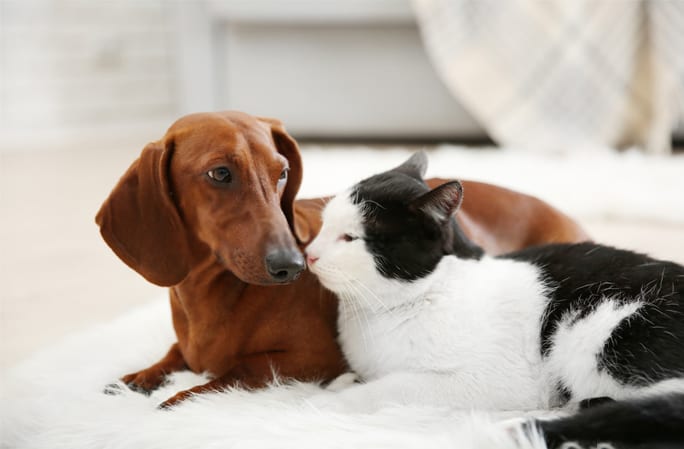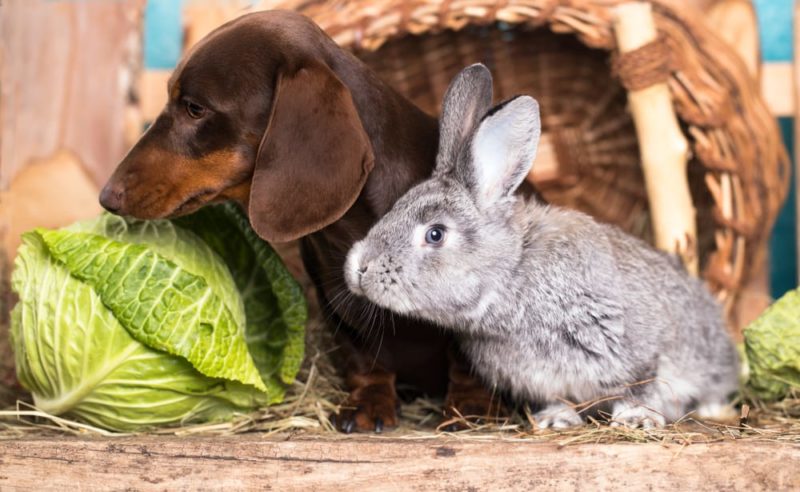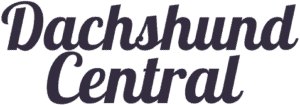
Introducing a new pet to the family can be an exciting and rewarding experience. But if you’re adding a dachshund to your home, it will require extra care and attention to ensure that the introduction process goes smoothly.
Dachshunds are small dogs with big personalities, so they need special consideration when it comes to introducing them to other pets like cats or larger dogs.
Fortunately, there are steps you can take that will help ensure that your dachshund is welcomed into his new home without any problems. In this blog post, we’ll look at how best to introduce a dachshund to other pets in the household
In this blog post, we’ll outline some tips on how best to introduce a dachshund to cats or larger dogs so that all members of the family are happy and healthy together.
Related post: Are dachshunds good for first-time owners?

Introducing a dachshund to other pets
Owning a dachshund can be quite complex, particularly when it comes to introducing them to other pets.
Controlling their prey drive and tendency to hunt smaller animals, is one of the most significant challenges that dachshund owners face introducing a dachshund to cats or other smaller pets, like rabbits. Introducing a dachshund to other dogs may also be challenging, as dachshunds can be jealous and territorial creatures.
Although it may take some effort and a great deal of perseverance. With proper planning, this endeavor is certainly doable!
Step 1: Assess the Temperament of All Involved Pets
Before attempting to introduce a dachshund and any other pet, the temperaments of all pets involved must be thoroughly assessed. If either one has exhibited aggression or fearfulness in the past, consulting with a professional trainer or behaviorist may be necessary before proceeding further.
To ensure a successful interaction between pets, underlying issues must first be addressed by an expert.
Step 2: Create a Safe and Controlled Environment
Setting a secure and controlled space when introducing your dachshund to another pet is key. Consider using a crate or separate room for the dachshund at first, as well as attaching them onto their leash or harness to control any potential aggressive behavior issues such as chasing or barking. By doing this, you will be able to make sure that both animals are safe during their initial introduction.
Step 3: Allow the Pets to Get Used to Each Other’s Scent
Before allowing the pets to meet face-to-face, it’s beneficial for them to become acclimated to each other’s scent. This can be done by putting a blanket or toy that has been touched by the other pet in your dachshund’s space or by allowing them to get acquainted through an obstacle like a baby gate. Doing so helps the animals in getting more familiarized with one another and may make their eventual introduction go even smoother.
Step 4: Start with Short and Supervised Introductions
Once your pets have grown accustomed to each other smell, it’s time to start introducing them. These initial meetings should be carefully monitored and conducted while either on a leash or separated by a barrier. Concentrate fully on these interactions as any signs of anxiety or hostility require immediate mediation.
If your dachshund is aggressive, remove it from the environment where the other pet is. When your dachshund calms down, try again. Stay calm throughout this process, dogs become even more aggressive if they feel their owner is anxious or stressed.
With patience and perseverance, you can steadily increase how long they interact with each other until both pets can be calm in the same room.
Step 5: Use Positive Reinforcement
During the initial introduction, positive reinforcement is essential to promote desirable behaviors. Offer treats, praises, and rewards when your pets are relaxed in one another’s presence! Unwanted actions such as barking or chasing must be immediately halted with a firm but calm ‘No’ while removing the dachshund from the scenario if need be. Utilizing these methods will aid in forming a secure bond between them.
Step 6: Gradually Increase Independence
After you have seen that the pets seem comfortable around each other during supervised encounters, it is time to slowly give them more liberties. This can be done by introducing some freedom for your dachshund in the presence of another pet or permitting a brief session together. As their relationship builds, make sure to keep an eye on them and immediately intervene if any issues arise.
Related post: Are Dachshunds Better In Pairs?
Consult with a professional
If you don’t feel like introducing another pet or dog to your dachshund. you can consult a veterinarian or canine trainer to help you in this process. To ensure a successful transition of introducing your dachshund to other pets, it’s always best to get help from an experienced veterinarian or professional trainer.
With their guidance and support, the process can be much smoother for everyone involved. Of course, with some effort and understanding on everyone’s part, you can create a warm home that cherishes each pet as a family member.
Related post: Can Rabbits and Dachshunds Live in the Same Home?

It is also important to remember to give each pet individual attention and to make sure that they are all getting their needs met. This can help prevent jealousy or resentment between the pets and can ensure that they all feel loved and valued.
Related post: Do Dachshunds Get Along With Other Dogs?
Final tips to introduce a dachshund to other pets
It is essential to remember that the introduction process may not be a seamless one, and it is only natural for there to be some hiccups along the way. As your pets become more accustomed to each other, they might need adjustments while getting used to their new environment. Therefore, suffice it to say it is important to stay patient and give them enough space as well as time during this period of mutual understanding.
Another important consideration when introducing a dachshund to other pets is to pay attention to body language. All animals communicate through body language, and it is essential to be tuned to the cues that your dachshund and the other pet are giving off.
Signs of aggression or discomfort may include growling, stiffening, or baring teeth. On the other hand, signs of relaxation and comfort may consist of wagging tails, relaxed body posture, and gentle panting. By paying attention to these cues, you can better understand how the pets are feeling and can intervene if necessary.
Related post: Are Dachshunds Good With Cats?
Conclusion:
In conclusion, introducing a dachshund to other pets can be a challenging but rewarding process. By following the steps outlined above, dachshund owners can set their pets up for success and create a happy and healthy home for all.
With a little bit of effort and understanding, it is possible to create a home where all pets are valued and loved members of the family.
Related post: The 7 reasons why dachshunds are good dogs



